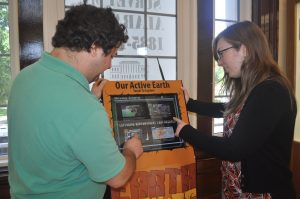
TUSCALOOSA, Ala. — Students and other museum visitors will now have vast earth science and geology information at their fingertips, thanks to a new permanent display at The University of Alabama’s Museum of Natural History.
The Incorporated Research Institutions for Seismology Active Earth Monitor Kiosk recently became a permanent addition at the museum. The customizable, computer-based earth science display allows museum visitors to explore earth geology, geologic settings, historical earthquake accounts and recent research about seismic activity, said Randy Mecredy, director of UA’s Alabama Museum of Natural History.
“Using touch-screen technology, you can view maps of real-time earthquake data and actual earthquake activity that has happened in the past few months,” Mecredy said. “Scroll through pages to learn about the geology of the New Madrid Seismic Zone. Read about eye witness accounts of earthquakes that occurred more than a century ago — there’s even a page on Myth Busting, such as the Mississippi River running backwards.”
Visitors can peruse pages of recent research with maps of national seismic hazards, information on newly discovered faults and learn about the varied challenges of forecasting future earthquakes in this region.
The display, which is located in the Rocks and Minerals exhibit in the museum’s Grand Gallery, was a joint effort between the museum and UA’s department of geological sciences.
Dr. Samantha Hansen, assistant professor of geological sciences, had originally applied for and received a one-year loan of the monitor, Mecredy said. At the end of the loan, the IRIS Consortium made the kiosk available for purchase, and the two areas combined resources to purchase the unique piece of equipment.
“Kids, students and adults are captivated by the digital technology and are intrigued by the information they can find,” Mecredy said. “We often see them checking back to see if any new seismic activity occurred since their last visit.”
UA’s Alabama Museum of Natural History is in Smith Hall near the Quad at the corner of Sixth Avenue and Capstone Drive on The University of Alabama campus. It is open 10 a.m. to 4:30 p.m. Monday through Saturday; admission is $2 per person.
Contact
Kim Eaton, UA media relations, 205/348-8325, kkeaton@ur.ua.edu
Source
Randy Mecredy, 205/348-7550, rmecredy@bama.ua.edu